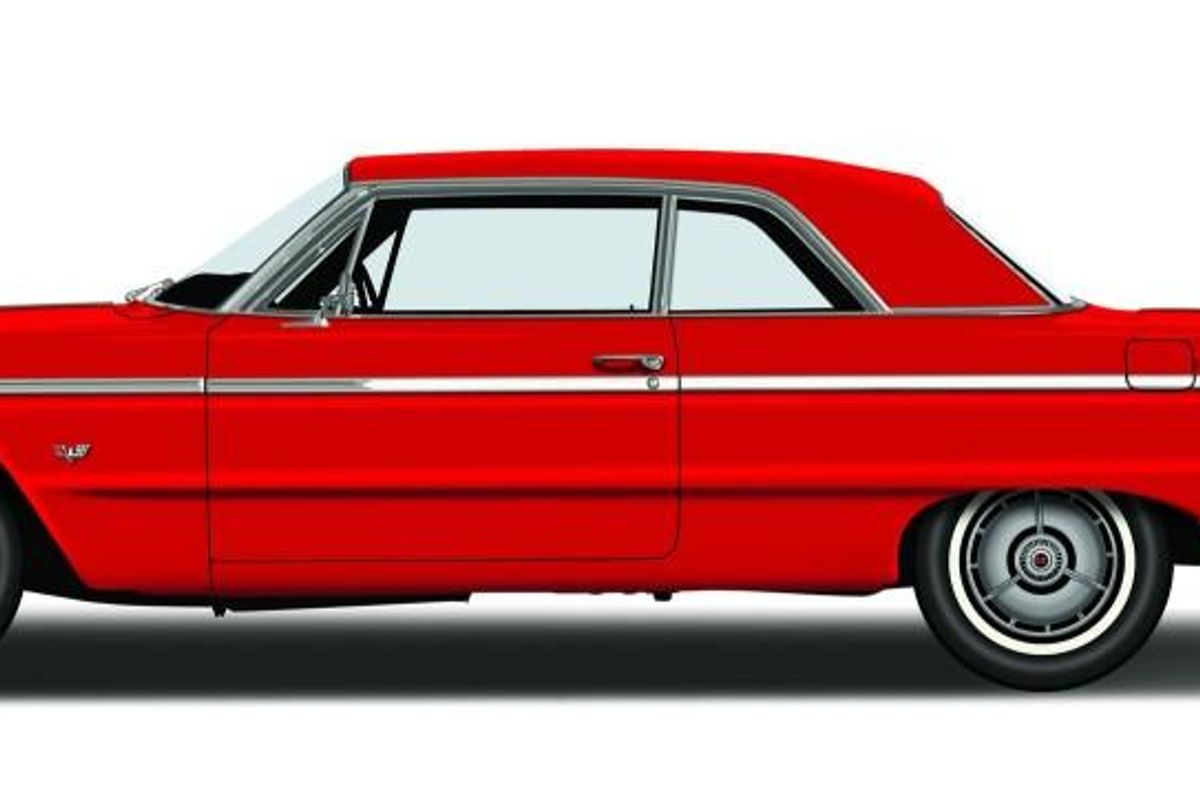
Buy
Resources
Entertainment
Magazine
Community
In This Article
Category:
Buyer's Guides
Chevrolet's 1964 Impala SS was a significant car but it earned its place in history more for what it ushered out, rather than any breakthroughs it ushered in.
When the all-new Impala was introduced in 1958, Chevrolet's biggest, most powerful engines were exclusive to its full-size cars. But 1964 brought the onslaught of big-block-powered intermediates and ponies, leading to an era when Detroit's longest automobiles emphasized luxury over quarter-mile E.T.s.
On the subject of Chevrolet's biggest, most powerful engines: The 409 was poised to ride off into the sunset in 1965 to make way for the Mark IV big-block's takeover. The 1964 model year turned out to be the last hurrah of the baddest regular-production W engine: the thundering dual-four-barrel 425-hp 409.
The '64 Impala was also a bookend for Chevrolet's X-frame-based chassis, a design that seemed to emphasize low-riding style over handling and safety. The division's 1965 full-size cars rode on more conventional perimeter frames.

Finally, as it was the last of the series, the '64 rolled into the model year with just some cosmetic updates as Chevrolet had been devoting its resources to the radically redesigned 1965 Impala.
Today, a '64 Impala SS makes a rewarding collectible for several reasons. Prices for early-to-mid 1960s Chevrolet hardtops have remained flat on average over the last decade--for all but the most desirable versions in concours condition--so getting into one today doesn't have to break your budget. (The possible exception being 409-powered, four-speed cars and, of course, convertibles.) Well-cared for 1964 Impalas with Super Sport trim are plentiful because they've long been considered collectible, but if you're in the market for a fixer upper, the parts supply for '64s is excellent, and the fan base for these cars is enormous.
While Chevrolet's full-size X-frame cars were never known for their corner-carving ability, when everything is in order, they negotiate modern traffic just fine. When upfitted with the myriad aftermarket steering, braking and suspension components available, X-frame cars can learn to move like Chevrolets half their age.
There's plenty to like about the 1964 Impala SS and seemingly no bad time to wade into the market. Here's some information to get you started.
ENGINE
Yes, Super Sports were available with the 140-hp Turbo-Thrift 230 six, but you're far more likely to find one today with a small block--even if it didn't come that way from the factory. Incidentally, the VIN of a '64 can reveal whether it's an SS V-8 or SS six-cylinder: Look for "13" as the second two digits of a six-cylinder SS; "14" for a V-8 SS. Differentiating between an original SS built with a small-block or a 409 can be trickier.
The base V-8 was the 195-hp Turbo-Fire 283 with a two-barrel carburetor. From there, buyers could upgrade to the 250-hp Turbo-Fire 327 with hydraulic lifters and a four barrel; the 300-hp 327 with mechanical lifters and a four barrel; the 340-hp 409 with a four barrel and hydraulic lifters; the 400-hp 409 with solid lifters and an aluminum intake or the 425-hp 409, which was more or less a 400-hp engine outfitted with dual Carter AFBs.
As you move up the engine food chain, prices rise dramatically. Not only is a big-block car more valuable than a small-block car, but the prices of 409 parts tend to run higher than small-block parts as well. A nice, original air box for a two-barrel 283 for instance might be found for around $100, while a nice original dual-four-barrel 409 air box can set you back 30 times that amount. There is some interchangeability between the small-block and the first-generation big-block, primarily among accessories: fuel pumps, oil pumps, starters, the bits inside the distributor but not the distributor itself, for instance. So most items you'll need to keep your Impala running are available through the local auto parts store. Of course, there are literally dozens of specialty vendors who can supply everything you'll ever need.
What to watch for: Engine swaps: It's easy to install a 409 in a 1964 Impala SS and can be difficult to prove that the engine isn't original. The pads on later high-performance engines (the rule of thumb is 300-hp and above) were often stamped with the car's partial VIN as well as a transmission code, but that can be duplicated, or conversely, the stamping could've been removed during a rebuild. Block casting numbers can help, as can casting dates. Also, later 409s had a fuel return line and used 3⁄8-inch fuel line routed to keep it away from dual exhaust. Small-block cars didn't have the return line, but high-performance 327 cars did have 3⁄8-inch line. Documentation is key to determining a car's value.
TRANSMISSION
The 230 six and the 283 V-8 were both available with the buyer's choice of a three-speed manual, a three-speed manual with optional two-speed planetary overdrive or a Powerglide two-speed automatic. Four-speed transmissions were not available on the two base engines.
Moving up to the 327 made a Muncie four-speed available as an option over the three-speed manual. The Powerglide was optional as well, but the three-speed manual with overdrive wasn't available with a 327 or a 409. The base 340-hp 409 was available only with a four-speed or the Powerglide while the 400-hp and 425-hp 409s were sold only with four-speed manual transmissions. Buyers of the most powerful 409s could order either a wide-ratio four speed with a 2.56:1 first gear (M20) or a close-ratio box with a 2.20:1 first gear (M21). All 327s and the 340-hp 409 were sold with the wide-ratio box.
What to watch for: The basic stuff. Manual transmissions that pop out of gear when you let off the accelerator, noisy throw-out bearings, grinding when going into gear or shifting. Incorrect transmissions might've been substituted over the years or automatics converted to four-speeds.
CHASSIS
The 1958-'64 X-frame placed the main frame support in the center of the Impala allowing the body to be dropped low to the ground. The design also required a two-piece driveshaft that passed through the center of the X and connected via a carrier bearing. Frame rust isn't typically an issue in the front and middle portions of the frame but can be in the rear rails surrounding the trunk floor.
These cars rode on coil springs at all four corners. The front used typical upper and lower stamped steel A-arms with ball joints and spindles. Power-assisted steering was available and used a conventional manual box with a hydraulic ram that pushed and pulled on the steering linkage.
The rear springs ride on beam-type lower control arms that pivot on brackets mounted outboard of the frame on one end and welded to the bottoms of the axle tubes on the other. There is a single upper control arm on the right side to help keep the axle from rotating and a diagonally mounted Panhard rod in the rear to locate the axle laterally.
The rear axle uses a drop-in carrier installed in the front of the housing. Limited-slip was available and factory third members with Positraction have a large letter "P" cast into the outside of the carrier.
Brakes were 11-inch drums at all corners with vacuum power assist available and a one-circuit master cylinder.
Parts are widely available for the steering, suspension and braking systems of X-frame Chevrolets. If factory-style replacement or reconditioned parts don't suit your plans for your car, there are dozens of aftermarket upgrades available.
What to watch for: Worn-out front and rear control-arm bushings, a carrier bearing and U-joints that are past prime, leaking power steering rams and loose steering joints can all add up to an Impala that's a chore to drive.
BODY & INTERIOR
By 1964 the Impala had sobered up from that wild party in 1959 that brought out the Dagmars, cat's-eye taillights, bat-wing fins and aircraft canopy shaped cockpits. The last of the X-frame Impalas avoided looking trendy, but the body panels were crisply creased and fashionable, like one of Don Draper's suits. Construction was fairly typical for a body-on-frame automobile: steel cowl, roof, underbody and rear quarters welded together to form a solid shell with bolt-on fenders, hood, doors and decklid.
Air could enter through vents at the base of the windshield and was channeled through the cowl and rocker panels. Unfortunately, once the vents and drains in the rockers were plugged with debris, moisture would rot the panels from the inside out. Common rust areas on these cars include the lower portions of the front fenders, the leading edge of the hood, door bottoms, rocker panels, quarter panels around the wheelhouses and, the lower portions of the trunk floor as well as the foot wells inside the cabin.
Replacement body panels for some of the earlier X-frame cars can be a challenge to locate, but the aftermarket has really stepped up to support the (similarly shaped) 1963-'64 cars with reproduction fenders, hoods, doors, quarter panels and floors.
Impala SS interiors featured thick foam buckets, deep-twist carpet, soft expanded vinyl-upholstered seats and door panels, bright trimmed center consoles with floor shifts for four-speed or Powerglide, as well as unique SS trim, courtesy lights and the buyer's choice of eight colors.
Excellent-quality interior kits are available as are a wide variety of interior accessories and trim, as well as carpet kits.
What to watch for: Super Sport trim on a non-SS car. Rust in the lower portions of the body and trunk.
ENGINE
There were seven engines available for the Impala SS. You won't find many around with six cylinders these days, but the rarity of an SS with an inline engine doesn't make it valuable. Cars with 409s on average bring the big money.
BRAKES
Stock drums with a one-pot master cylinder are okay for AACA shows, but upgrading to a dual-chamber master is easy and safer. Power disc brake kits are plentiful and many bolt up in an afternoon.
TRANSMISSION
Odds are if you're shopping for a 1964 Impala SS and reading HMM, you want a four-speed. Aluminum-case Muncies were used in these cars, not Borg-Warner T-10s, as in earlier Impalas. If you like automatics, but not Powerglides, there are many options for upgrading to a Turbo-Hydramatic.
INTERIOR
There's no reason to drive one of these cars around with a shabby-looking cockpit. Practically everything you need to make the living quarters of your '64 Impala SS like new is being reproduced today.
CHASSIS
X-frame cars had a floaty ride with plenty of body roll, but when everything is up to snuff, they really aren't bad to drive. Power steering kits with modern boxes are a nice upgrade on drivers. Springs of all weights and heights, shocks as well as anti-roll bars are all available.
BODY
These cars rusted in all of the typical locations--fender and door bottoms, rockers, rear wheelhouses--but the availability of aftermarket (and rust-free original in dry parts of the country) body panels for 1964 Impalas is excellent.
The 1964 Impala was the last hurrah for Chevrolet's X-frame cars. For '64, Super Sport became its own series. Outside, there were SS emblems on the quarters and wheel covers, but only the 409 got an engine callout above the flag logo. This car is powered by a 300-hp 327.
My father and I stumbled upon this Impala back in the early '90s at the Kruse auction at the Charlotte AutoFair. Back in those days, every once in a while, we'd score a "gem" at that auction. This was one of those gems. When we looked it over, and eventually won it,
we assumed the car was a very nicely restored example, and we were attracted by the great combination of colors and driveline. It wasn't until we got it home to our shop, and started doing our normal 'due-diligence,' that we slowly realized the paint was all-original, the interior all-original, all the bright work, etc. Holy cow, that 21,000 miles on the odometer was actually original mileage! It quickly became apparent that we'd purchased a low-mile survivor that had been treated to some very nice cosmetic-detailing of the engine compartment and undercarriage, but was otherwise 100 percent original and unrestored. So, long story short, it's a dandy car... Not just because it's a red '64 SS with the 327/300 four-speed driveline, but also because I don't think I'd be able to find a finer one without it being a full restoration. And even then, it wouldn't be the same. Suffice it to say, it runs and drives like a brand-new Impala would.--Rick Schmidt
WHAT TO PAY
Add 5 percent for 250-hp 327, 20 percent for 300-hp 327, 60 percent for 409, 75 percent for 425-hp 409.
Add $500-$1,000 for four-speed.
HARD PARTS
Full rear quarter panel: $435
One-piece trunk floor: $465
Hood: $379
Front fender: $340
Door shell: $490
Trunk lid: $470
Windshield: $260
Rear window: $300
Grille: $420
ENGINE
TRANSMISSION
DIFFERENTIAL
BRAKES
WHEELS AND TIRES
PRODUCTION
1964 Impala SS: 185,325
PERIOD ROAD TEST RESULTS
Source: Motor Trend, March 1963
Recent
On this episode of Repair2Rev, join us as Riley and Dane share invaluable tips and tricks on tackling one of the most crucial aspects of vehicle maintenance: the brakes. From the essential do's and don'ts to the step-by-step process of replacing and upgrading front disc brakes, you'll learn everything you need to know to keep your ride safe and reliable.
As they move to the rear of the truck they delve into the intricate world of rear drum brake systems, demonstrating the art of rebuilding and restoring this often-overlooked component of classic trucks. And to ensure your truck stops on a dime, they'll wrap up the episode with a comprehensive guide to bleeding the brake system, leaving no stone unturned in their quest for peak performance. Knowledge gained here will help you find your bargain buy without the anxiety of lacking repair tips. Hemmings is the ultimate destination for finding your perfect ride. Head to Hemmings.com to register and start your search today.
The British motor industry is well represented on this week’s round up of successful sales on Hemmings.com. The strongest listing went to an LS V8-powered 1997 Land Rover Defender 110 custom that outperformed the market and looked to be able to well outperform a stock 110. A 1978 Aston Martin AM V8 found a new home via auction, the same fate experienced by a V12-powered 1972 Jaguar XKE Series 3 roadster. The original Jeep Grand Wagoneer was perhaps the first luxury SUV and the 1988 example sold on Hemmings.com featured low-mileage and excellent overall condition. There are few muscle cars are instantly recognizable as a Carousel Red Pontiac GTO Judge, like the 1969 model detailed below. Finally, we look at a restored 1913 Ford Model T Runabout sold from a Canadian-based collection.
For the week of May 12 through May 18, a total of 61 listings crossed the Hemmings Auctions block. Including Make Offer listings of previously ended auctions, a total of 40 cars were sold, resulting in a net 66% sell-through rate. An additional 29 cars were sold via direct Make Offer listings.
You can keep abreast of the latest consignments by subscribing to the daily Hemmings Auctions email newsletter.
1978 Aston Martin AM V8
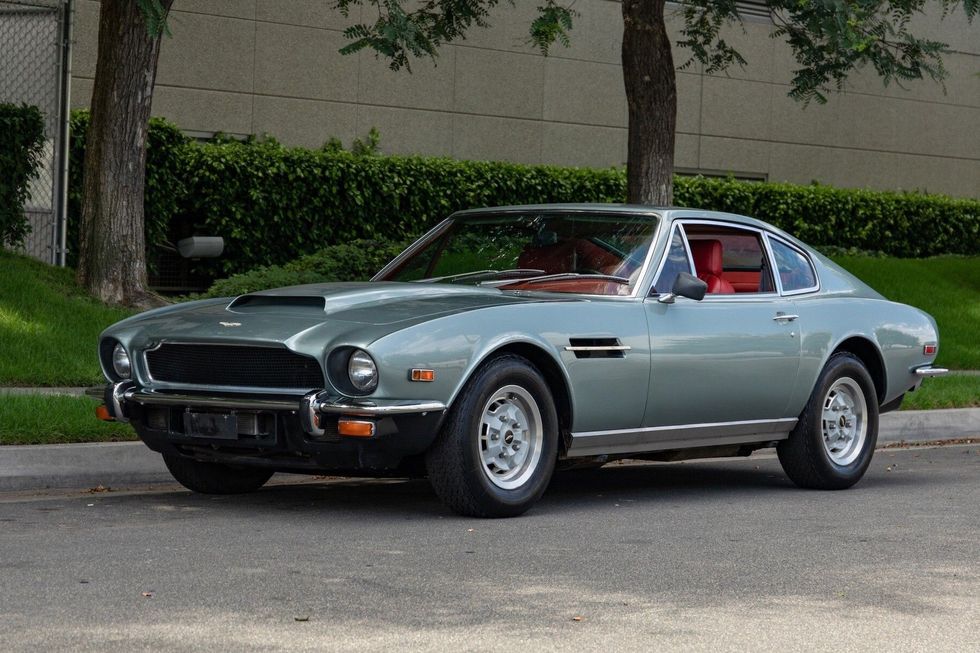
Reserve: $80,000
Selling Price: $84,000
Recent Market Range: $45,000-$80,000
Aston Martin produced some version of its V8-powered saloon from 1969 through 1989, though we are more likely to refer to the body style as a coupe on this side of the Atlantic. A beefy 5.3-liter DOHC V8 with multiple carburetors and a stout Chrysler-sourced TorqueFlite automatic very much gave the models a muscle car vibe, albeit one made with fine leather upholstery and thick wool carpets. This silver on red 1978 Aston Martin AM V8 Series III saloon, which traded hands last year via online auction for $46,988, achieved one of the highest prices seen in recent years for a coupe equipped with a standard-specification engine, particularly outside the U.K., where values are typically stronger.
1988 Jeep Grand Wagoneer
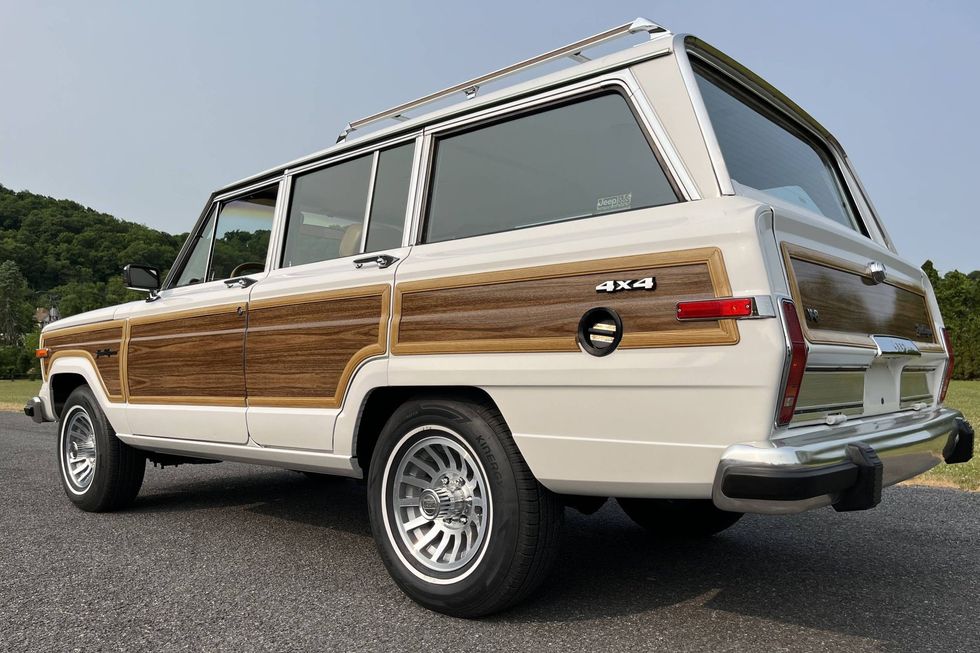
Reserve: $63,000
Selling Price: $68,775
Recent Market Range: $54,000-$75,000
Perhaps no other American vehicle has combined class and off-road capability quite like the original Grand Wagoneer, the trailblazing luxury SUV that was produced by Jeep for almost three decades. This 1988 Jeep Grand Wagoneer was submitted with just 27,417 miles showing on the odometer and plenty of notes from the seller indicating the original condition of the vehicle and all of its major components. The undercarriage, interior and engine bay photos all appeared to show an exceptionally clean example, which is notable for a rust-prone vehicle that has been in the Northeast since new. The net sale price, achieved with the 39th bid, was in line with market expectations for this very collectible vehicle.
1997 Land Rover Defender 110

Asking Price: $150,000
Selling Price: $157,500
Recent Market Range: $80,000-$150,000
The Land Rover Defender market shows no signs of slowing down, particularly as more and more examples are allowed into the U.S. via the DOT’s 25-year rule for previously banned imports. Likewise, there is a burgeoning market for what can best be described as restomodded examples, like this 1997 Land Rover Defender 110, which was powered by a modern GM LS3 V8, the same powerplant found in later C6 Corvettes. The list of what was original to this SUV might be shorter than what was changed, given the comprehensive nature of the build. Achieved via a direct Make Offer listing, the net sale price of this Land Rover was at the very top end of recent market activity for such customized Defenders.
1969 Pontiac GTO Judge
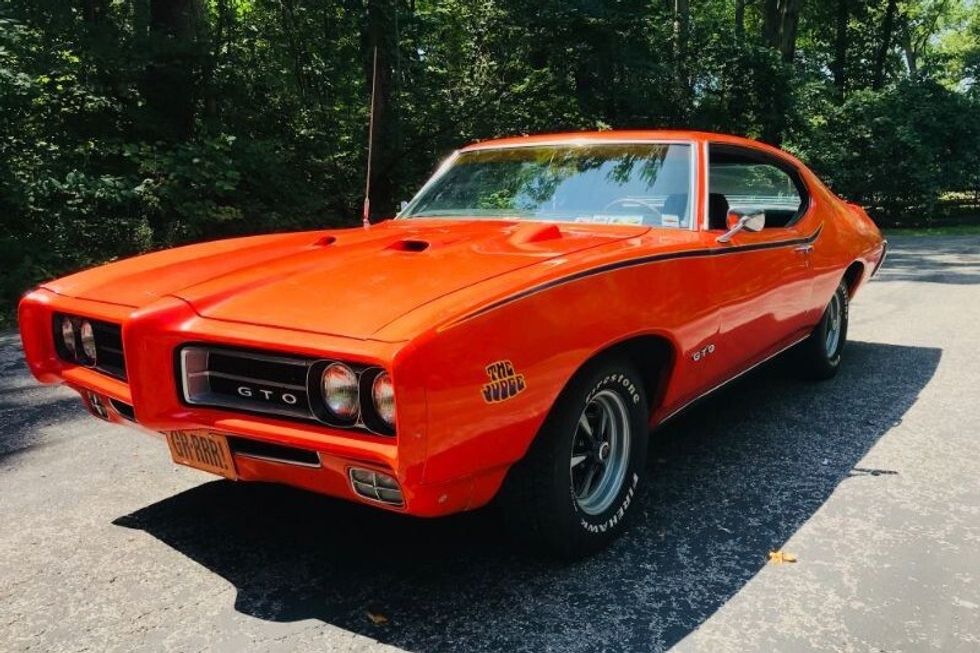
Reserve: $54,000
Selling Price: $52,500
Recent Market Range: $46,000-$62,000
This 1969 Pontiac GTO Judge ticked all the right boxes: matching numbers with photos verification of the partial VIN stamping on the engine block of the original Ram Air III V8, Muncie four-speed manual transmission, PHS documentation, and that classic Carousel Red finish and Judge decals. It looked to be in excellent overall condition, but it also appeared to have been driven and enjoyed some in recent years, with some signs of wear. And the net sale price, achieved via post-auction Make Offer listing, reflected the condition and authenticity of the car. A concours-level example, or one with a rare Ram Air IV engine for example, would likely command a premium over this one.
1972 Jaguar E-type Series III Roadster
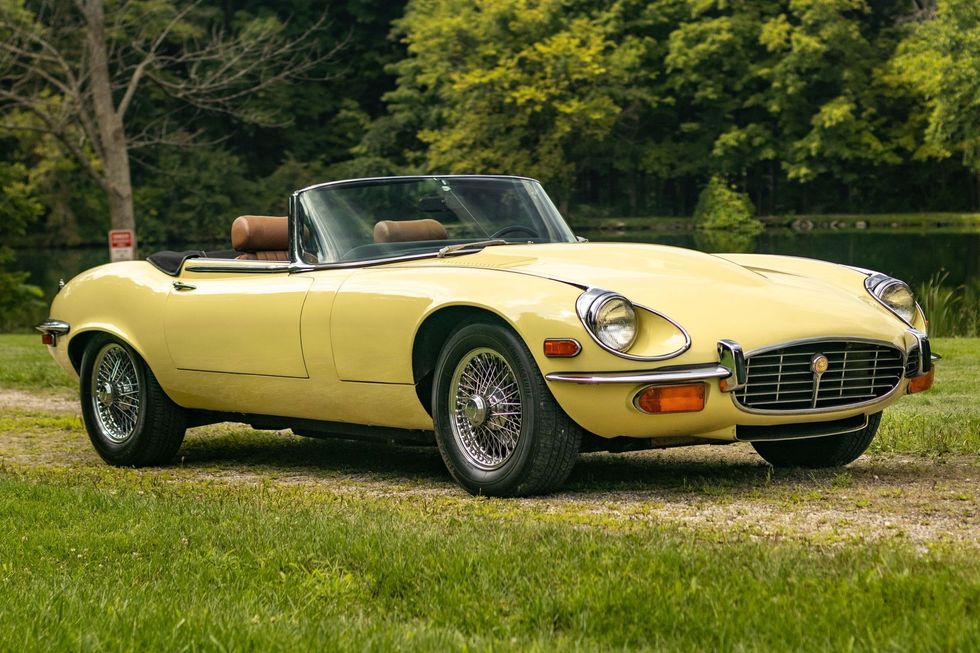
Reserve: $65,000
Selling Price: $69,825
Recent Market Range: $78,000-$115,000
The final iteration of the Jaguar XKE was a bit larger than the original and not as precisely focused on its sporting nature. Rather, with a big V12 under the hood, it was more of a GT car. This 1972 Jaguar E-type Series III Roadster appeared to have some minor wear and tear and signs of road use, but it made up for any shortcomings with what appeared to be an abundance of authenticity. The seller noted that the exterior finish, interior upholstery and engine were all original. Reflecting the low number of owners and the car’s years sitting in a museum, the odometer reading of just over 30,000 miles was also believed accurate. While the net sale price was below market expectations, it was not too far off.
1913 Ford Model T Runabout
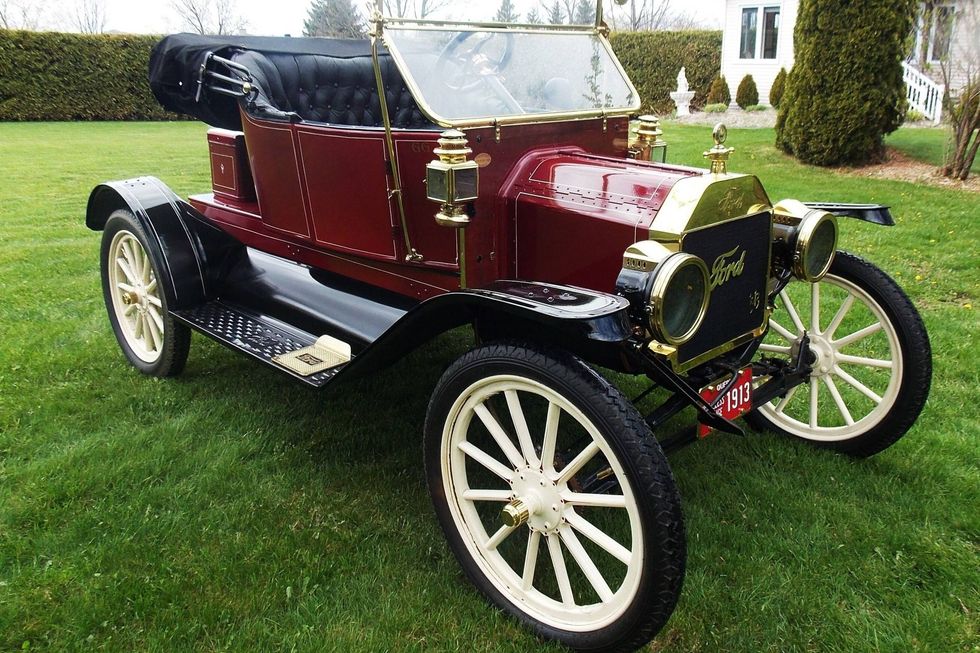
Reserve: $25,00
Selling Price: $26,250
Recent Market Range: $22,000-$36,000
There has never been a shortage of early Fords at Hemmings, dating to the earliest days of our magazine. Like any other vehicle, the most desired examples in the best condition will always attract the bidders. This 1913 Ford Model T Runabout appeared to have been restored to high level and showed only minimal signs of use. It was also equipped with an electric starter. The maroon body, black fenders and white spoke wheels nicely complemented the button-tufted black vinyl seat. The undercarriage appeared to be exceptionally clean, indicating little use for the car that was said to come from a Model T collection. The next sale price was well within the going market rate for an open-top, two-seat, early Model T.
Keep reading...Show Less
Interested in a new or late model used car?





